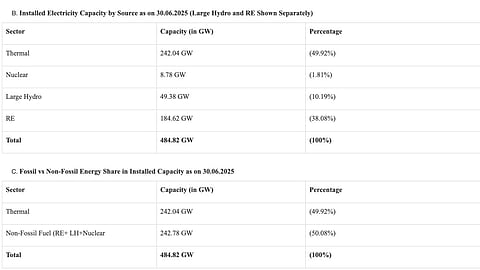

India met its 2030 clean energy target 5 years early, hitting 50% installed capacity
Solar dominates with 116.2 GW, supported by rooftop, hybrid, off-grid, and ground-mounted systems
Digitalization, AI, and energy storage are the next focus areas to ensure round-the-clock clean power
India has achieved its 2030 goal of sourcing 50% of its installed power capacity from clean energy, 5 years ahead of schedule. Non-fossil fuel sources now contribute 242.8 GW out of the nation’s total installed power capacity of 484.8 GW.
As of June 30, 2025, the country’s non-fossil fuel capacity comprised 184.62 GW of renewable energy, 49.38 GW of large hydro, and 8.78 GW of nuclear energy.
Solar power leads the renewable energy segment with a combined 116.2 GW, including 89.3 GW of ground-mounted, 18.84 GW of grid-connected rooftop solar, 3.06 GW of solar in hybrid projects, and 5.05 GW of off-grid solar capacity. It achieved the 100 GW milestone for solar in February 2025 (see India Exceeds 100 GW Solar PV Capacity Milestone).
India had been targeting a 50% clean energy share in its total power mix under its Nationally Determined Contributions (NDC) commitment to the Paris Agreement.
The Ministry of New and Renewable Energy (MNRE) attributes this milestone to ‘visionary policy design, bold implementation, and the country’s deep commitment to equity and climate responsibility.’
It lists flagship programs such as the Pradhan Mantri Kisan Urja Suraksha evam Utthaan Mahabhiyan (PM-KUSUM), PM Surya Ghar: Muft Bijli Yojana, solar park development, and the National Wind-Solar Hybrid Policy as the strong drivers of this transition.
Going ahead, the ministry plans to integrate AI, digitalization, and energy storage (BESS, pumped hydro) to ensure 24x7 clean power as it targets 500 GW non-fossil capacity by 2030 and net-zero by 2070. Priorities for the industry will be to boost access to clean electricity for the rural and underserved regions by promoting distributed renewable systems and energy-efficient appliances, circularity in solar/wind materials, grid resilience, and strong cybersecurity, among other measures.
“As the power sector becomes increasingly reliant on data and digital infrastructure, cybersecurity must be prioritised. Protecting critical infrastructure from cyber threats, data breaches, and algorithmic manipulation is integral to ensuring a secure and resilient energy system,” stated the ministry.
